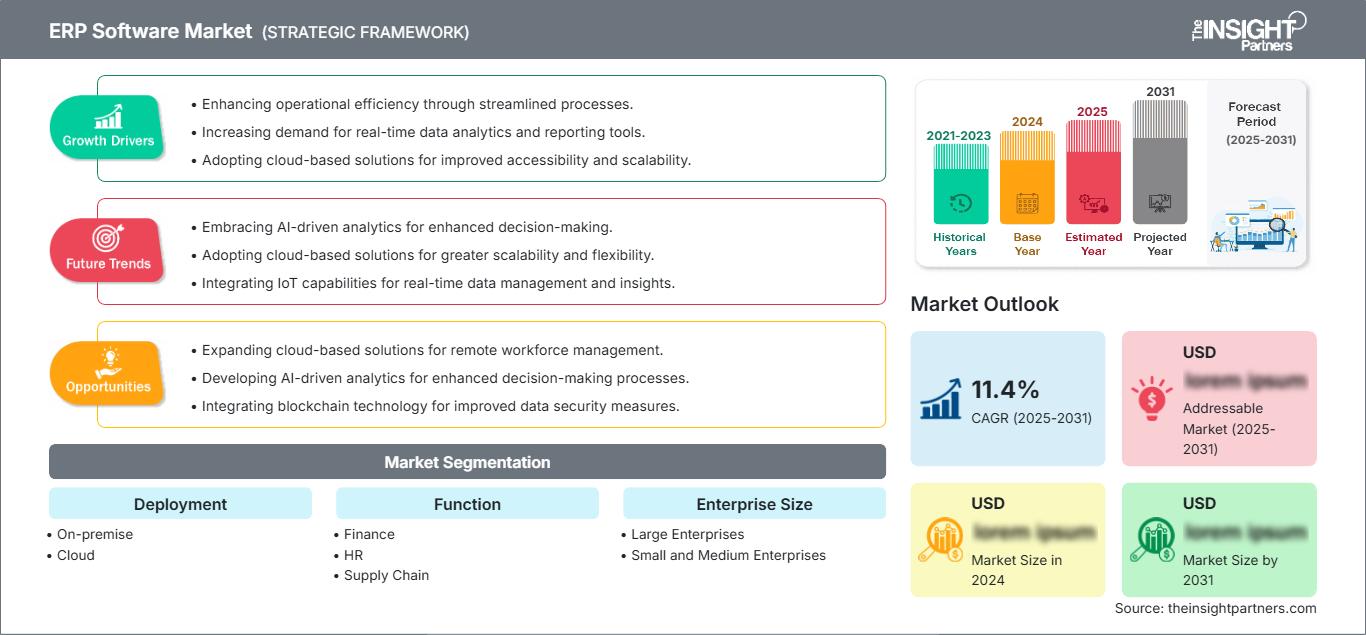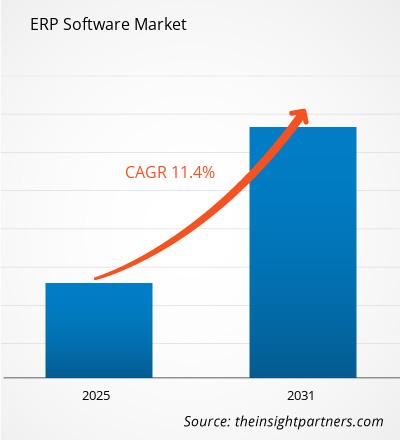Der Markt für ERP-Software wird bis 2031 voraussichtlich ein Volumen von 129,64 Milliarden US-Dollar erreichen. Für den Zeitraum 2025–2031 wird ein jährliches Wachstum von 8,8 % erwartet.
Der Bericht ist segmentiert nach Bereitstellung (On-Premise, Cloud), Funktion (Finanzen, Personalwesen, Lieferkette, Sonstige), Unternehmensgröße (Großunternehmen, KMU) und Branche (Fertigung, Banken, Finanzdienstleistungen und Versicherungen, Einzelhandel, Gesundheitswesen, Telekommunikation, Sonstige). Die globale Analyse wird zudem auf regionaler Ebene und für wichtige Länder aufgeschlüsselt. Der Bericht gibt die Werte für die oben genannten Analysen und Segmente in US-Dollar an.
Zweck des Berichts
Der Bericht „ERP-Software-Markt“ von The Insight Partners beschreibt die aktuelle Marktlage und das zukünftige Wachstum sowie die wichtigsten Treiber, Herausforderungen und Chancen. Dies wird verschiedenen Akteuren im Geschäftsbereich Einblicke ermöglichen, wie beispielsweise:
- Technologieanbieter/Hersteller: Um die sich entwickelnde Marktdynamik zu verstehen und potenzielle Wachstumschancen zu erkennen, können sie fundierte strategische Entscheidungen treffen.
- Investoren: Um eine umfassende Trendanalyse hinsichtlich Marktwachstumsrate, Finanzprognosen und Chancen entlang der Wertschöpfungskette durchzuführen.
- Regulierungsbehörden: Um Richtlinien zu regulieren und Aktivitäten auf dem Markt zu überwachen, mit dem Ziel, Missbrauch zu minimieren, das Vertrauen der Anleger zu wahren und die Integrität und Stabilität des Marktes zu gewährleisten. ERP-Software-Marktsegmentierung: Bereitstellung
- On-Premise
- Cloud
Funktion
- Finanzen
- Personalwesen
- Lieferkette
Unternehmensgröße
- Großunternehmen
- Kleine und mittlere Unternehmen
Branche
- Fertigung
- Banken, Finanzdienstleistungen und Versicherungen
- Einzelhandel
- Gesundheitswesen
- Telekommunikation
Passen Sie diesen Bericht Ihren Anforderungen anSie erhalten kostenlos Anpassungen an jedem Bericht, einschließlich Teilen dieses Berichts oder einer Analyse auf Länderebene, eines Excel-Datenpakets sowie tolle Angebote und Rabatte für Start-ups und Universitäten.
ERP-Softwaremarkt: Strategische Einblicke

- Holen Sie sich die wichtigsten Markttrends aus diesem Bericht.Dieses KOSTENLOSE Beispiel umfasst Datenanalysen, die von Markttrends bis hin zu Schätzungen und Prognosen reichen.
Wachstumstreiber des ERP-Softwaremarktes
- Digitale Transformation: Unternehmen setzen zunehmend auf ERP-Software, um Geschäftsprozesse zu optimieren, heterogene Systeme zu integrieren und umfassende operative Transparenz zu erreichen. Die wachsende Komplexität globaler Geschäftsumgebungen, verbunden mit dem Bedarf an Echtzeit-Datenanalysen und -Entscheidungsfindung, veranlasst Unternehmen, in anspruchsvolle ERP-Lösungen zu investieren. Diese ermöglichen eine durchgängige Prozessoptimierung, reduzieren operative Silos und steigern die Agilität des gesamten Unternehmens. Dieser Faktor ist besonders wichtig für Unternehmen, die sich in einem sich schnell entwickelnden Marktumfeld Wettbewerbsvorteile sichern wollen.
- Management komplexer Geschäftsökosysteme: Die zunehmende Komplexität globaler Lieferketten, internationaler Geschäftstätigkeiten und Unternehmensumgebungen mit mehreren Standorten zwingt Unternehmen zur Implementierung robuster ERP-Systeme. Diese Lösungen bieten entscheidende Funktionen für das Management komplexer Finanzberichte, die Sicherstellung der Einhaltung regulatorischer Vorgaben in verschiedenen Jurisdiktionen, die Abwicklung von Transaktionen in verschiedenen Währungen und die Bereitstellung einheitlicher operativer Erkenntnisse. Unternehmen erkennen ERP-Software als unverzichtbares Werkzeug, um die komplexen Herausforderungen des internationalen Geschäfts zu meistern, vielfältige operative Anforderungen zu erfüllen und eine reibungslose Kommunikation in globalen Unternehmensnetzwerken zu gewährleisten.
Zukunftstrends im ERP-Softwaremarkt
- Zunehmende Nutzung cloudbasierter ERP-Lösungen: Der Trend zu cloudbasierten ERP-Systemen wird sich weiter beschleunigen, da Unternehmen nach skalierbaren, kosteneffizienten und leicht zugänglichen Lösungen suchen. Cloudbasierte ERP-Systeme bieten zahlreiche Vorteile, darunter geringere Vorlaufkosten, schnellere Implementierungszeiten, automatische Updates und eine verbesserte Zusammenarbeit verteilter Teams. Diese Systeme ermöglichen es Unternehmen, von überall auf Echtzeitdaten zuzugreifen, was zu fundierteren Entscheidungen und höherer operativer Agilität führt. Da die Cloud-Sicherheit kontinuierlich verbessert wird, werden immer mehr Unternehmen, darunter auch kleine und mittlere Unternehmen (KMU), cloudbasierte ERP-Systeme einführen und traditionelle On-Premise-Lösungen ersetzen.
- Integration mit fortschrittlichen Technologien wie KI, IoT und Blockchain: Die Integration von künstlicher Intelligenz (KI), dem Internet der Dinge (IoT) und Blockchain-Technologien in ERP-Systeme wird die Arbeitsweise von Unternehmen grundlegend verändern. KI und maschinelles Lernen werden für prädiktive Analysen eingesetzt und automatisieren Aufgaben wie Bedarfsplanung, Bestandsmanagement und Finanzprognosen. IoT-Geräte werden in ERP-Systeme integriert, um Echtzeitdaten von vernetzten Anlagen bereitzustellen und so intelligentere Entscheidungen in Fertigung, Logistik und Anlagenmanagement zu ermöglichen. Die Blockchain-Technologie bietet verbesserte Sicherheit, Transparenz und Rückverfolgbarkeit im Lieferkettenmanagement, bei der Vertragsabwicklung und bei Finanztransaktionen und erweitert damit die Leistungsfähigkeit von ERP-Systemen.
Marktchancen für ERP-Software
- Branchenspezifische und vertikal angepasste ERP-Lösungen: Die wachsende Nachfrage nach spezialisierter ERP-Software, die auf branchenspezifische Anforderungen eingeht, bietet ein bedeutendes Marktpotenzial. Anbieter können hochgradig individualisierte ERP-Lösungen entwickeln, die auf spezifische Branchen wie Fertigung, Gesundheitswesen, Einzelhandel und professionelle Dienstleistungen abzielen. Diese maßgeschneiderten Lösungen bieten vorkonfigurierte Workflows, branchenspezifische Compliance-Funktionen, spezialisierte Reporting-Tools und tiefgreifende domänenspezifische Funktionalitäten, die Unternehmen in bestimmten Branchen einen unmittelbaren Mehrwert und eine schnellere Implementierung ermöglichen.
- Integration von Künstlicher Intelligenz und Advanced Analytics: Die Integration von Künstlicher Intelligenz und Advanced Analytics in ERP-Software birgt ein erhebliches Innovationspotenzial. ERP-Systeme können KI nutzen, um prädiktive Erkenntnisse zu gewinnen, Routineprozesse zu automatisieren, die Entscheidungsfindung zu verbessern und anspruchsvollere Business Intelligence zu generieren. Es bestehen Möglichkeiten zur Entwicklung von ERP-Lösungen, die Algorithmen des maschinellen Lernens für Bedarfsplanung, intelligente Ressourcenallokation, vorausschauende Wartung und operative Echtzeitoptimierung integrieren und ERP so von einem transaktionalen System zu einer strategischen Business-Intelligence-Plattform transformieren.
ERP-Softwaremarkt
Die regionalen Trends und Einflussfaktoren auf den ERP-Softwaremarkt im gesamten Prognosezeitraum wurden von den Analysten von The Insight Partners ausführlich erläutert. Dieser Abschnitt behandelt außerdem die Marktsegmente und die geografische Verteilung des Marktes für das Management von Herzrhythmusstörungen in Nordamerika, Europa, Asien-Pazifik, dem Nahen Osten und Afrika sowie Süd- und Mittelamerika.
Umfang des ERP-Software-Marktberichts
Berichtsattribut Einzelheiten Marktgröße in 2024 US$ XX Billion Marktgröße nach 2031 US$ 129.64 Billion Globale CAGR (2025 - 2031) 8.8% Historische Daten 2021-2023 Prognosezeitraum 2025-2031 Abgedeckte Segmente By Bereitstellung - vor Ort
- Cloud
- Finanzen
- Personalwesen
- Lieferkette
- Großunternehmen
- kleine und mittlere Unternehmen
- Fertigung
- BFSI
- Einzelhandel
- Gesundheitswesen
- Telekommunikation
Abgedeckte Regionen und Länder Nordamerika - USA
- Kanada
- Mexiko
- Großbritannien
- Deutschland
- Frankreich
- Russland
- Italien
- Restliches Europa
- China
- Indien
- Japan
- Australien
- Restlicher Asien-Pazifik
- Brasilien
- Argentinien
- Restliches Süd- und Mittelamerika
- Südafrika
- Saudi-Arabien
- Vereinigte Arabische Emirate
- Restlicher Naher Osten und Afrika
Marktführer und wichtige Unternehmensprofile - Epicor Software Corporation
- Hewlett-Packard Development Company, L.P.
- Infor Inc.
- IBM Corporation
- Microsoft
- NetSuite Inc.
- Oracle
- Sage Group, plc
- SAP SE
- Unit4
Dichte der ERP-Software-Anbieter: Auswirkungen auf die Geschäftsdynamik
Der Markt für ERP-Software wächst rasant, angetrieben durch die steigende Nachfrage der Endnutzer. Gründe hierfür sind unter anderem sich wandelnde Verbraucherpräferenzen, technologische Fortschritte und ein wachsendes Bewusstsein für die Vorteile des Produkts. Mit steigender Nachfrage erweitern Unternehmen ihr Angebot, entwickeln innovative Lösungen, um den Kundenbedürfnissen gerecht zu werden, und nutzen neue Trends, was das Marktwachstum zusätzlich beflügelt.

- Holen Sie sich die ERP-Softwaremarkt Übersicht der wichtigsten Akteure
Wichtigste Verkaufsargumente
- Umfassende Abdeckung: Der Bericht bietet eine umfassende Analyse der Produkte, Dienstleistungen, Typen und Endnutzer des ERP-Softwaremarktes und vermittelt so ein ganzheitliches Bild.
- Expertenanalyse: Der Bericht basiert auf dem fundierten Wissen von Branchenexperten und Analysten.
- Aktuelle Informationen: Der Bericht gewährleistet Geschäftsrelevanz durch die Berücksichtigung aktueller Informationen und Datentrends.
- Anpassungsmöglichkeiten: Dieser Bericht kann an spezifische Kundenanforderungen angepasst werden und sich optimal in die Geschäftsstrategien integrieren.
Der Forschungsbericht zum ERP-Softwaremarkt kann somit maßgeblich dazu beitragen, das Branchenszenario und die Wachstumsaussichten zu entschlüsseln und zu verstehen. Auch wenn einige berechtigte Bedenken bestehen, überwiegen die Vorteile dieses Berichts in der Regel die Nachteile.
- Historische Analyse (2 Jahre), Basisjahr, Prognose (7 Jahre) mit CAGR
- PEST- und SWOT-Analyse
- Marktgröße Wert/Volumen – Global, Regional, Land
- Branchen- und Wettbewerbslandschaft
- Excel-Datensatz
Aktuelle Berichte
Verwandte Berichte
Markt für Etikettierungssoftware für Unternehmen Markt für ESG-Reporting-Software Markt für Flugplanungssoftware Markt für Lebensmittelrückverfolgbarkeitssoftware Markt für Gerätevermietungssoftware Markt für Engineering-Software Markt für Bodenbelagskalkulationssoftware Markt für Finite-Elemente-Analysesoftware Markt für Lebensmittelherstellungssoftware Markt für Dateikonverter-Software Markt für Enterprise-AR-Software Markt für Finanzforschungssoftware Markt für Dateimigrationssoftware Markt für Enterprise-Workflow-Automatisierungssoftware Markt für Floristensoftware Markt für Enterprise-Architektur-Software Markt für Frachtmaklersoftware Markt für Finanzberichtssoftware Markt für PLM-Software für die Modebranche ETL-SoftwaremarktErfahrungsberichte
Grund zum Kauf
- Fundierte Entscheidungsfindung
- Marktdynamik verstehen
- Wettbewerbsanalyse
- Kundeneinblicke
- Marktprognosen
- Risikominimierung
- Strategische Planung
- Investitionsbegründung
- Identifizierung neuer Märkte
- Verbesserung von Marketingstrategien
- Steigerung der Betriebseffizienz
- Anpassung an regulatorische Trends




















 Kostenlose Probe anfordern für - ERP-Softwaremarkt
Kostenlose Probe anfordern für - ERP-Softwaremarkt